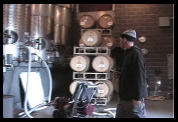| Upon
arrival, we found the October weather in St. Helena to be warm
and inviting, yet with a hint of cooler conditions to come. The
perfect environment to roll up one's sleeves and
participate in the harvest.
We hoped we'd really be a help and not get in the way.
We arrived at 8 AM Monday morning and
looked for Aaron
Pott, the winemaker (at the time).
Aaron
immediately made us feel a welcome part of the staff and interns,
and after a brief exploration into his background, he invited us to taste the various red wines directly from
the fermentation tanks.
|
 |
| Arriving
at the winery - Day One |
|
|
This is a daily ritual of swirling,
swishing and spitting. The winemaker draws up his taste buds to determine how
each of the wines is coming along in the fermentation process. We
started with Cabernet Franc, a minor but key constituent of their
Oroppas Meritage. We moved along the row of tall silver tanks (photos
at right) and went on to taste Merlot, Cabernet Sauvignon and other
varietals. One of our
first reactions to the taste, even this early in the process, was
that Aaron is very good at producing a soft and smooth wine. They
were quite frankly, already excellent on the palate.
One of the nice things
about St. Clement is that they're small enough to take the time and
loving care that larger wineries may not have the luxury to do. We
noticed this extra care each step of the way (as in the hand-sorting of
grapes). The steps listed here are what we observed in RED
winemaking (the tank tasting mentioned above
is part of Step
3 in this list):
- After the grapes are
picked in the vineyard, they're rushed to the winery for
de-stemming and crushing.
- St. Clement actually
hand sorts grapes at this stage. Something most wineries don't
have the luxury of doing.
- The grapes are
crushed and de-stemmed then moved to tank as gently as possible.
The skins, seeds and juice (collectively called must) will
remain in the tank during fermentation (5-7 days) and maceration
(between 12 and 50 days beyond the fermentation). The maceration
period allows St. Clement to soften the wines and extract more
intensity from the fruit.
- After maceration,
the grapes are pressed and the press is combined (or not) with
the free run wine.
After the tank tasting,
Aaron took us to a couple of the many vineyards the winery owns. It
was educational to see how he judges when the grapes are ready for
harvest and to be told of the many factors that influence the flavor
and ripeness of the fruit (soil, climate, ensuing weather).
After lunch and wine
(of course), we were asked to punch down a small batch of Charbono,
being made exclusively for their wine club members. The batch was in
white plastic bins as opposed to the large metal tanks used for
large volumes of production. Three to five times a day, this
mixing of the must is performed to ensure even fermentation, since
the lighter materials tend to rise to the top. This action ensures a
more even mixture.
While we were performing these tasks, we saw the other winery staff doing
things like updating charts that track fermentation, pump overs, filtering
and re-positioning barrels full of aging wine. Cheerful
dispositions are the norm all day. These people clearly enjoy
what they do. It's hard work, but they obviously love it!
One of the highlights
of our day was being invited to put on pant coveralls and shovel out
one of the tall fermentation tanks. Joaquin had drained the tank,
but as we soon found out, that wasn't enough. They showed us how to
contort our bodies to allow passage inside, via the hole at the
bottom of the tank.
Three
photographs at right, without black border, show us preparing to climb
in, the two of us shoveling out the remaining skins, and then
pausing triumphantly after emptying the tank.
It took the two of us
about 15 minutes to get it all out. We had harnesses and ropes
attached to our waists in case they needed to pull us out. Even with
the fan going, the fumes can topple you unconscious. The gang
cheered when we survived! Cool.
With the last punch
down, we ended our first work day. We were sore in muscles we
didn't know we had, but enjoyed the gratification of honest hard
work and the fact that it was in this most enjoyable of wine
regions.
|
Note:
most photos
can be
enlarged by
CLICKING ON THEM |
 |
| Aaron
Pott swirling & tasting wine from the fermentation tank. |
 |
| Aaron
oversees operations in the winery. Fermentation tanks and
barrels in background. |
 |
| Pump
Over! |
 |
| Preparing
to climb into the tank. |
 |
| Shoveling
out remaining skins. |
 |
| Tank
empty! |
|
|